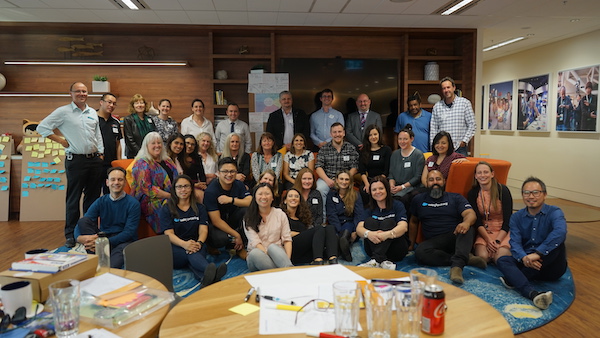Today, employees are demanding more from the companies they work for. And we’re not talking about more ‘bring your dog to work’ days.
Just as customers expect organisations to prove their moral mettle when it comes to equality, diversity and access, so do employees. At a time when filling positions is a significant challenge for businesses of all sizes, building a values-driven culture has never been more important for attracting and retaining great talent.
Volunteer time off (VTO) programs can be a powerful tool in an organisation’s mission to recruit and keep employees who are the right fit for the business. A meaningful VTO scheme demonstrates a business is willing to walk its talk on its values — and that’s appealing to customers and employees alike.

Here at Salesforce, our VTO program is part of our 1:1:1 model which we use to fulfil co-founder Marc Benioff’s vision of a world made better by business. In 2019, our Australian team volunteered more than 40,000 hours, with people like volunteer fire brigade captain John Watson and cyclist Gareth Williams setting incredible examples of what’s possible when VTO is built into an organisation’s culture. And for volunteers assisting with the Australian bushfire recovery, Salesforce has increased its VTO from seven to 27 days per year.

We have seen the extraordinary benefits of a successful VTO scheme up close and personal, and Salesforce’s VTO scheme is proof that nothing about a well-managed VTO program detracts from business success.
But such schemes are rarely straightforward to implement. For a VTO scheme to take hold and add value to an organisation’s culture, it has to be carefully planned and managed.
Here are the three common challenges that many businesses face when adopting VTO programs and some strategies for overcoming them.
Matching good intentions with good corporate social responsibility
Most employees will be eager to make the most of their VTO but they might not know where to start looking. Businesses can help volunteers find a cause and uphold their corporate social responsibility by:
- Encouraging employees to look to their existing community networks for opportunities – family, neighbourhoods, schools – and focus on causes they care about.
- Creating a platform for employees to share volunteer opportunities internally.
- Supplying a go-to list of local nonprofits that could use help.
- Initiating and creating opportunities involving the business. For example, host a company-wide half-day or day-long activity. Local food banks or shelters are a great place to start.

Showing the C- suite that VTO is good for business
Executives concerned about a decline in productivity and associated hit on revenue will be reassured by the evidence showing VTO helps businesses succeed.
Contributing to the community makes us feel good individually, but it also makes for better, more cohesive teams. VTO experiences can develop valuable new skills and nurture adaptability, resilience and empathy – all qualities that employees can bring back to the workplace with them.
Moreover, VTO schemes can be a powerful way of improving brand recognition and reputation for businesses at a time when customers are more concerned than ever with a company’s ethics. Salesforce research shows 80% of customers are more loyal to companies with good ethics and 68% of customers won’t buy from companies with poor ethics.
Just as employees’ responsibilities are looked after when they are on personal or holiday leave, the same can happen while taking VTO.
Remember, losing an employee can cost tens of thousands of dollars, so making VTO a key part of your retention strategy is just smart business.

Empowering employees to take VTO
Employees may be understandably cautious about taking VTO if their organisation is not demonstrably supportive of it. Here are some ways to show your employees that you take VTO seriously.
- Make sure senior leaders set the example. When the C-suite takes VTO, that sends a strong message of encouragement.
- Make volunteering part of the workplace culture. Employees are willing to spend more time doing volunteer work when the organisational culture is healthy and when they enjoy recognition among their peers. Post photos, stories and names of those who volunteered so they are recognised for their contributions.
- Make volunteering easy and convenient.
- Incentivise volunteering. Consider company-specific incentives:
- Dollars for doers: Offer dollars per hour spent volunteering, then let employees donate this money in addition to their time.
- Matching: Challenge senior leadership or your board to match every hour spent volunteering.
- Points: Create a competitive atmosphere where you have a total number of hours your company is trying to achieve, and report on this in quarterly meetings.
- Start small. Offer one to two days a year to start and gauge interest; if people use their hours, consider offering more the following year.

It’s clear VTO programs instil a culture of community service in the workplace and are incredibly powerful. Salesforce volunteers return from VTO – whether it be a local fundraiser or a major international project – invigorated and inspired, with a fresh perspective and new skills. Who wouldn’t want employees like that?
Learn how to bring your organisation’s culture and values to life with our free Salesforce Ohana Culture learning module on Trailhead.























